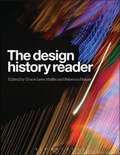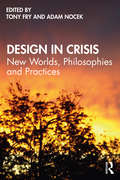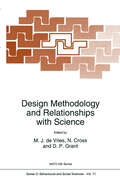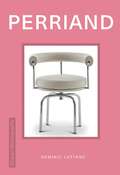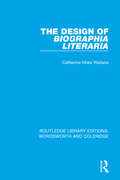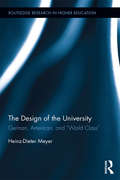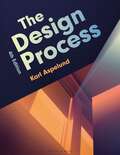- Table View
- List View
Design History Beyond the Canon
by Jennifer Kaufmann-Buhler Victoria Rose Pass Christopher WilsonDesign History Beyond the Canon subverts hierarchies of taste which have dominated traditional narratives of design history. The book explores a diverse selection of objects, spaces and media, ranging from high design to mass-produced and mass-marketed objects, as well as counter-cultural and sub-cultural material. The authors' research highlights the often marginalised role of gender and racial identity in the production and consumption of design, the politics which underpins design practice and the role of designed objects as pathways of nostalgia and cultural memory. While focused primarily on North American examples from the early 20th century onwards, this collection also features essays examining European and Soviet design history, as well as the influence of Asia and Africa on Western design practice. The book is organised in three thematic sections: Consumers, Intermediaries and Designers. The first section analyses a range of designed objects and spaces through the experiences and perspectives of users. The second section considers intermediaries from both technology and cultural industries, as well as the hidden labour within the design process itself. The final section focuses on designers from multiple design disciplines including high fashion, industrial design, interior design, graphic design and design history pedagogy. The essays in all three sections utilise different research methods and a wide range of theoretical approaches, including feminist theory, critical race theory, spatial theory, material culture studies, science and technology studies and art history. Design History Beyond the Canon brings together the most recent research which stretches beyond the traditional canon and looks to interdisciplinary methodologies to better understand the practice and consumption of design.
Design History Beyond the Canon
by Christopher Wilson Victoria Rose Pass Jennifer Kaufmann-BuhlerDesign History Beyond the Canon subverts hierarchies of taste which have dominated traditional narratives of design history. The book explores a diverse selection of objects, spaces and media, ranging from high design to mass-produced and mass-marketed objects, as well as counter-cultural and sub-cultural material. The authors' research highlights the often marginalised role of gender and racial identity in the production and consumption of design, the politics which underpins design practice and the role of designed objects as pathways of nostalgia and cultural memory. While focused primarily on North American examples from the early 20th century onwards, this collection also features essays examining European and Soviet design history, as well as the influence of Asia and Africa on Western design practice. The book is organised in three thematic sections: Consumers, Intermediaries and Designers. The first section analyses a range of designed objects and spaces through the experiences and perspectives of users. The second section considers intermediaries from both technology and cultural industries, as well as the hidden labour within the design process itself. The final section focuses on designers from multiple design disciplines including high fashion, industrial design, interior design, graphic design and design history pedagogy. The essays in all three sections utilise different research methods and a wide range of theoretical approaches, including feminist theory, critical race theory, spatial theory, material culture studies, science and technology studies and art history. Design History Beyond the Canon brings together the most recent research which stretches beyond the traditional canon and looks to interdisciplinary methodologies to better understand the practice and consumption of design.
The Design History Reader (PDF)
by Grace Lees-Maffei Rebecca HouzeThe first systematic and comprehensive reader on Design History, this book examines the role of design and designed objects within social and cultural history. Extracts range from the 18th century, when design and manufacture separated, to the present day. Drawn from scholarly and polemical books, research articles, exhibition catalogues, and magazines, the extracts are placed in themed sections, with each section separately introduced and each concluded with an annotated guide to further reading. Covering both primary texts (such as the writings of designers and design reformers) and secondary texts (in the form of key works of design history), the reader provides an essential resource for understanding the history of design, the development of the discipline, and contemporary issues in design history and practice. Selected authors: Judy Attfield, Jeremy Aynsley, Rayner Banham, Roland Barthes, Jean Baudrillard, Walter Benjamin, Pierre Bourdieu, Christopher Breward, Denise Scott Brown, Ruth Schwarz Cowan, Clive Dilnot, Buckminster Fuller, Paul Greenhalgh, Dick Hebdige, Steven Heller, John Heskett, Pat Kirkham, Adolf Loos, Victor Margolin, Karl Marx, Jeffrey Meikle, William Morris, Gillian Naylor, Victor Papanek, Nikolaus Pevsner, John Ruskin, Adam Smith, Penny Sparke, John Styles, Nancy Troy, Thorstein Veblen, Robert Venturi, John Walker, Frank Lloyd Wright.
Design in Crisis: New Worlds, Philosophies and Practices
by Tony Fry Adam NocekThis book is an essential contribution to the transdisciplinary field of critical design studies. The essays in this collection locate design at the center of a series of interrelated planetary crises, from climate change, nuclear war, and racial and geopolitical violence to education, computational culture, and the loss of the commons. In doing so, the essays propose a range of needed interventions in order to transform design itself and its role within the shifting realities of a planetary crisis. It challenges the widely popular view that design can contribute to solving world problems by exposing how this attitude only intensifies the problems we currently face. In this way, the essays critique the dominant modes of framing the meaning and scope of design as a largely Anglo-European 'problem-solving' practice. By drawing on post-development theory, decolonial theory, black studies, continental philosophy, science and technology studies, and more, the contributions envision a critical and speculative practice that problematises both its engagement with planet and itself. The essays in this collection will appeal to design theorists and practitioners alike, but also to scholars and students generally concerned with how the past and future of design is implicated in the unfolding complexity of ecological devastation, racial and political violence, coloniality, technological futures, and the brutality of modern Western culture generally.
Design in Crisis: New Worlds, Philosophies and Practices
by Tony Fry Adam NocekThis book is an essential contribution to the transdisciplinary field of critical design studies. The essays in this collection locate design at the center of a series of interrelated planetary crises, from climate change, nuclear war, and racial and geopolitical violence to education, computational culture, and the loss of the commons. In doing so, the essays propose a range of needed interventions in order to transform design itself and its role within the shifting realities of a planetary crisis. It challenges the widely popular view that design can contribute to solving world problems by exposing how this attitude only intensifies the problems we currently face. In this way, the essays critique the dominant modes of framing the meaning and scope of design as a largely Anglo-European 'problem-solving' practice. By drawing on post-development theory, decolonial theory, black studies, continental philosophy, science and technology studies, and more, the contributions envision a critical and speculative practice that problematises both its engagement with planet and itself. The essays in this collection will appeal to design theorists and practitioners alike, but also to scholars and students generally concerned with how the past and future of design is implicated in the unfolding complexity of ecological devastation, racial and political violence, coloniality, technological futures, and the brutality of modern Western culture generally.
Design: The Key Concepts (Routledge Key Guides)
by Catherine McDermottThis is the essential student’s guide to Design – its practice, its theory and its history. Drawing from a wide range of international examples, respected design writer Catherine McDermott explores key topics including: international design – from Europe to Africa design history – from Art Nouveau to punk sustainable design, recycling and green design design theory – from semiotics to gender, to postcolonialism design technology, graphic design and the web. Fully cross-referenced, with up-to-date guides for further reading, Design: The Key Concepts is an indispensable reference for students of design, design history, fashion, art and visual culture.
Design: The Key Concepts (Routledge Key Guides)
by Catherine McDermottThis is the essential student’s guide to Design – its practice, its theory and its history. Drawing from a wide range of international examples, respected design writer Catherine McDermott explores key topics including: international design – from Europe to Africa design history – from Art Nouveau to punk sustainable design, recycling and green design design theory – from semiotics to gender, to postcolonialism design technology, graphic design and the web. Fully cross-referenced, with up-to-date guides for further reading, Design: The Key Concepts is an indispensable reference for students of design, design history, fashion, art and visual culture.
Design Methodology and Relationships with Science (NATO Science Series D: #71)
by D. P. Grant N. Cross M. J. VriesMany business corporations are faced with the challenge of bringing together quite different types of knowledge in design processes: knowledge of different disciplines in the natural and engineering sciences, knowledge of markets and market trends, knowledge of political and juridical affairs. This also means a challenge for design methodology as the academic discipline that studies design processes and methods. The aim of the NATO ARW of which this book is the report was to bring together colleagues from different academic fields to discuss this increasing multidisciplinarity in the relationship between design and sciences. This multidisciplinarity made the conference a special event. At a certain moment one of the participants exclaimed: "This is not a traditional design methodology conference!" Throughout the conference it was evident that there was a need to develop a common language and understanding to enable the exchange of different perspectives on design and its relationship with science. The contributions that have been included in this book show these different perspectives: the philosophical, the historical, the engineering perspective and the practical designer's experience.
Design Monograph: Gaudí
by Judith Carmel-ArthurA design monograph series on the most remarkable architects, designers, brands and design movements of the twentieth and twenty-first centuries, each book contains a historical-critical essay discussing the life and work of the subject, followed by an illustrated appreciation of groundbreaking work.The 'Dante of architecture', Antoni Gaudí crafted extraordinary constructions out of minute and mesmerizing details, transforming fantastical visions into realities on the city streets of Barcelona. His work merged the influences of Orientalism, natural forms, new materials and religious faith into a unique aesthetic. From the furnishings of the Güell Palace to his masterpiece, the still-incomplete Sagrada Família, his imaginative creations are celebrated in this curated selection of images, accompanied by an essay of his life and work.
Design Monograph: Gehry
by Naomi StungoA design monograph series on the most remarkable architects, designers, brands and design movements of the twentieth and twenty-first centuries, each book contains a historical-critical essay discussing the life and work of the subject, followed by an illustrated appreciation of groundbreaking work.Frank Gehry transformed contemporary architecture with his innovative use, and range, of materials and forms, from mass-produced items to titanium and 3D computer modelling. Remarkable, surprising, and revealing a sense of flow and movement, his buildings curve, bend and collapse in unexpected ways. From his most famous masterpiece, the Guggenheim Museum Bilbao, to his Dancing House in Prague and the twisting Luma Arles Tower, his experimental shapes inspire awe and wonder.
Design Monograph: Perriand
by Dominic LutyensA design monograph series on the most remarkable architects, designers, brands and design movements of the twentieth and twenty-first centuries, each book contains a historical-critical essay discussing the life and work of the subject, followed by an illustrated appreciation of groundbreaking work.French architect and designer Charlotte Perriand not only created buildings such as the League of Nations in Geneva and ski resorts but was responsible for iconic furniture pieces in tubular steel, such as the Nuage bookshelf, Grand Confort chair (while working for Le Corbusier), B301 recliner and the ponyskin Chaise Longue.
The Design Museum – Fashion Evolution: The 250 looks that shaped modern fashion
by Design Museum Enterprise LimitedFrom the Chanel suit to the Wonderbra, via Jackie Kennedy, Ziggy Stardust and Alexander McQueen, respected fashion journalist and editor Paula Reed explores each of the styles and visionaries that have defined the way we dress. Spanning fifty years - from the 1950s to the 1990s - and accompanied by striking photographs throughout, Fashion Evolution is the definitive story of the style moments that changed the world.
Design Noir: The Secret Life of Electronic Objects (Radical Thinkers in Design)
by Anthony Dunne Fiona RabyThe first book to be published on the work of their partnership (in 2001), Design Noir is the essential primary source for understanding the theoretical and conceptual underpinnings for Dunne & Raby's work. Consisting of three elements - a 'manifesto' on the possibilities of designing with and for the 'secret life' of electronic objects; notes for an embryonic network of critical designers and, most famously, the presentation of the Placebo Project – a prototype for a critical design poetics enacted around electronic furniture-objects – Design Noir offers an in-depth exploration of one of the most seminal design projects of the last two decades, one that arguably initiated speculating through design in its contemporary forms. By detailing the logic and character of the objects that were constructed; the involvement of users with these objects over-time, and in the creation of a new kinds of spatially and temporally distributed moments of critique and engagement with things, Design Noir presents the case-study of the Placebo projectas a far more complex and subtler project than is often thought. As a bold and in many ways unprecedented experiment in design writing and book designing, Design Noir is itself an instance of the speculative propositional design it expounds.
Design Noir: The Secret Life of Electronic Objects (Radical Thinkers in Design)
by Anthony Dunne Fiona RabyThe first book to be published on the work of their partnership (in 2001), Design Noir is the essential primary source for understanding the theoretical and conceptual underpinnings for Dunne & Raby's work. Consisting of three elements - a 'manifesto' on the possibilities of designing with and for the 'secret life' of electronic objects; notes for an embryonic network of critical designers and, most famously, the presentation of the Placebo Project – a prototype for a critical design poetics enacted around electronic furniture-objects – Design Noir offers an in-depth exploration of one of the most seminal design projects of the last two decades, one that arguably initiated speculating through design in its contemporary forms. By detailing the logic and character of the objects that were constructed; the involvement of users with these objects over-time, and in the creation of a new kinds of spatially and temporally distributed moments of critique and engagement with things, Design Noir presents the case-study of the Placebo projectas a far more complex and subtler project than is often thought. As a bold and in many ways unprecedented experiment in design writing and book designing, Design Noir is itself an instance of the speculative propositional design it expounds.
Design Objects and the Museum
by Liz Farrelly Joanna WeddellDesign Objects and the Museum brings together leading design historians, curators, educators and archivists to consider the place of contemporary design objects within museums. Contributors draw on a wide range of 20th century and contemporary examples from international museums to consider how design objects have been curated and displayed within and beyond the museum. The book continues contemporary global debates on the ways in which museums of design engage and educate their public.Chapters are grouped into three thematic sections addressing The Canon and Design in the Museum; Positioning Design within and Beyond the Museum; and Interpretation and the Challenge of Design, with chapters exploring museological practice and issues, the roles people play in creating meaning, and the challenges contemporary design presents to interpretation and learning within the museum.
Design Objects and the Museum
by Liz Farrelly Joanna WeddellDesign Objects and the Museum brings together leading design historians, curators, educators and archivists to consider the place of contemporary design objects within museums. Contributors draw on a wide range of 20th century and contemporary examples from international museums to consider how design objects have been curated and displayed within and beyond the museum. The book continues contemporary global debates on the ways in which museums of design engage and educate their public.Chapters are grouped into three thematic sections addressing The Canon and Design in the Museum; Positioning Design within and Beyond the Museum; and Interpretation and the Challenge of Design, with chapters exploring museological practice and issues, the roles people play in creating meaning, and the challenges contemporary design presents to interpretation and learning within the museum.
The Design of Biographia Literaria (RLE: Wordsworth and Coleridge)
by Catherine M. WallaceFirst published in 1983, this book examines a work whose intricacies have baffled and infuriated generations of readers and proposes a theory of Coleridge’s writing habits that "explain(s) his explanation". The author painstakingly analyses the Biographia’s organising structure distinguishing between the daring conception and often inept execution of Coleridge’s idea of critical discourse. It is argued that Coleridge’s autobiographical format present a richly metaphorical "self" whose literary life has led to the now-famous doctrine of secondary imagination. The author’s command of Coleridge scholarship will shed new light on the Biographia for specialists and non-specialists alike.
The Design of Biographia Literaria (RLE: Wordsworth and Coleridge)
by Catherine M. WallaceFirst published in 1983, this book examines a work whose intricacies have baffled and infuriated generations of readers and proposes a theory of Coleridge’s writing habits that "explain(s) his explanation". The author painstakingly analyses the Biographia’s organising structure distinguishing between the daring conception and often inept execution of Coleridge’s idea of critical discourse. It is argued that Coleridge’s autobiographical format present a richly metaphorical "self" whose literary life has led to the now-famous doctrine of secondary imagination. The author’s command of Coleridge scholarship will shed new light on the Biographia for specialists and non-specialists alike.
The Design of Childhood: How the Material World Shapes Independent Kids
by Alexandra LangeFrom building blocks to city blocks, an eye-opening exploration of how children's playthings and physical surroundings affect their development.Parents obsess over their children's playdates, kindergarten curriculum, and every bump and bruise, but the toys, classrooms, playgrounds, and neighborhoods little ones engage with are just as important. These objects and spaces encode decades, even centuries of changing ideas about what makes for good child-rearing--and what does not. Do you choose wooden toys, or plastic, or, increasingly, digital? What do youngsters lose when seesaws are deemed too dangerous and slides are designed primarily for safety? How can the built environment help children cultivate self-reliance? In these debates, parents, educators, and kids themselves are often caught in the middle.Now, prominent design critic Alexandra Lange reveals the surprising histories behind the human-made elements of our children's pint-size landscape. Her fascinating investigation shows how the seemingly innocuous universe of stuff affects kids' behavior, values, and health, often in subtle ways. And she reveals how years of decisions by toymakers, architects, and urban planners have helped--and hindered--American youngsters' journeys toward independence. Seen through Lange's eyes, everything from the sandbox to the street becomes vibrant with buried meaning. The Design of Childhood will change the way you view your children's world--and your own.
The Design of the University: German, American, and “World Class” (Routledge Research in Higher Education)
by Heinz-Dieter MeyerWhat is the reason for the American university’s global preeminence? How did the American university succeed where the development of the German university, from which it took so much, stalled? In this closely-argued book, Meyer suggests that the key to the American university’s success is its institutional design of self-government. Where other university systems are dependent on the patronage of state, church, or market, the American university is the first to achieve true autonomy, which it attained through an intricate system of engagements with societal actors and institutions that simultaneously act as amplifiers of its impact and as checks on the university’s ever-present corrosive tendencies. Built on a searching analysis of the design thinking of Wilhelm von Humboldt and Adam Smith and closely tracing the learning process by which Americans adapted the German model, The Design of the University dismisses efforts to copy superficial features of the American university in order to achieve world-class rank. Calling attention to the design details of the university and the particulars of its institutional environment, this volume identifies the practices and choices that produced the gold standard for today’s world class higher education.
The Design of the University: German, American, and “World Class” (Routledge Research in Higher Education #26)
by Heinz-Dieter MeyerWhat is the reason for the American university’s global preeminence? How did the American university succeed where the development of the German university, from which it took so much, stalled? In this closely-argued book, Meyer suggests that the key to the American university’s success is its institutional design of self-government. Where other university systems are dependent on the patronage of state, church, or market, the American university is the first to achieve true autonomy, which it attained through an intricate system of engagements with societal actors and institutions that simultaneously act as amplifiers of its impact and as checks on the university’s ever-present corrosive tendencies. Built on a searching analysis of the design thinking of Wilhelm von Humboldt and Adam Smith and closely tracing the learning process by which Americans adapted the German model, The Design of the University dismisses efforts to copy superficial features of the American university in order to achieve world-class rank. Calling attention to the design details of the university and the particulars of its institutional environment, this volume identifies the practices and choices that produced the gold standard for today’s world class higher education.
Design, Philosophy and Making Things Happen (Design Research for Change)
by Brian S. DixonDrawing from the work of Dewey, Wittgenstein and Heidegger, this book aims to relate a series of philosophic insights to the practice of engaging in design research for change. These insights are explored and presented as a set of potential strategies for grounding transformative design research within an intellectual context which both embraces and celebrates experience, process and uncertainty. Chapter by chapter, through theory, practical examples and case studies, an accessible narrative opens up around the coupled themes of existence and experience, language and meaning and knowing and truth. The outcome is a rich and detailed perspective on the ways in which philosophy may afford design research for change a means to both explain, as well as understand, not only what it is and what it does, but also what it could be. The book will be of interest to scholars working in design studies, design theory and design research.
Design, Philosophy and Making Things Happen (Design Research for Change)
by Brian S. DixonDrawing from the work of Dewey, Wittgenstein and Heidegger, this book aims to relate a series of philosophic insights to the practice of engaging in design research for change. These insights are explored and presented as a set of potential strategies for grounding transformative design research within an intellectual context which both embraces and celebrates experience, process and uncertainty. Chapter by chapter, through theory, practical examples and case studies, an accessible narrative opens up around the coupled themes of existence and experience, language and meaning and knowing and truth. The outcome is a rich and detailed perspective on the ways in which philosophy may afford design research for change a means to both explain, as well as understand, not only what it is and what it does, but also what it could be. The book will be of interest to scholars working in design studies, design theory and design research.
The Design Process: - with STUDIO
by Karl AspelundIn The Design Process, Fourth Edition author Karl Aspelund takes readers on a guided tour through the seven stages of design: from the initial Inspiration to Identification, Conceptualization, Exploration/Refinement, Definition/Modeling, Communication, and all the way through Production. This book focuses on developing a solid foundation in design critical thinking, no matter the discipline. The author highlights the all important factors of sustainability, teamwork, and how to best communicate with client or manufacturer. Each chapter is followed by an exercise that allows you to work on one full cross-disciplinary project continuously from brainstorm to a physical product. The appendices provide key references to further readings, artist profiles, design elements and principles, trend analysis, and history of modern design (from the 1800s through to the 21st century). This is the perfect book to make your design dreams into design reality.New to This Edition:-Updated examples, exercises, bibliography, and timelines-Revised coverage of sustainability reflects the newest findings in the field-New and revised Perspectives offer real life examples from artists and designers across fashion, interior design, public arts projects, and industrial and consumer productsInstructor Resources-Instructor's Guide provides suggestions for planning the course and using the text in the classroom, supplemental assignments, and lecture notes-Test Bank includes sample test questions for each chapter-PowerPoint® presentations include images from the book and provide a framework for lecture and discussionSTUDIO Includes: -Study smarter with self-quizzes featuring scored results and personalized study tips
The Design, Production and Reception of Eighteenth-Century Wallpaper in Britain (The Histories of Material Culture and Collecting, 1700-1950)
by Clare TaylorWallpaper’s spread across trades, class and gender is charted in this first full-length study of the material’s use in Britain during the long eighteenth century. It examines the types of wallpaper that were designed and produced and the interior spaces it occupied, from the country house to the homes of prosperous townsfolk and gentry, showing that wallpaper was hung by Earls and merchants as well as by aristocratic women. Drawing on a wide range of little known examples of interior schemes and surviving wallpapers, together with unpublished evidence from archives including letters and bills, it charts wallpaper’s evolution across the century from cheap textile imitation to innovative new decorative material. Wallpaper’s growth is considered not in terms of chronology, but rather alongside the categories used by eighteenth-century tradesmen and consumers, from plains to flocks, from China papers to papier mâché and from stucco papers to materials for creating print rooms. It ends by assessing the ways in which eighteenth-century wallpaper was used to create historicist interiors in the twentieth century. Including a wide range of illustrations, many in colour, the book will be of interest to historians of material culture and design, scholars of art and architectural history as well as practicing designers and those interested in the historic interior.


